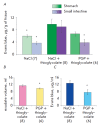Prolyl-glycyl-proline (PGP) Peptide Prevents an Increase in Vascular Permeability in Inflammation
- PMID: 28461974
- PMCID: PMC5406660
Prolyl-glycyl-proline (PGP) Peptide Prevents an Increase in Vascular Permeability in Inflammation
Abstract
This study was aimed at investigating the effect of prolyl-glycyl-proline (PGP) tripeptide on vascular permeability in rats with an inflammation. It was found that the peptide reduces the rat paw edema induced by a subcutaneous administration of histamine to the same extent as the conventional anti-inflammatory agent diclofenac. However, an assessment of the relative expression level of the cox-2 gene at the inflammation focus using real-time PCR showed that, in contrast to diclofenac, PGP does not affect the cox-2 gene expression. This is indicative of the fact that they have different mechanisms of action. We used the model of acute peritonitis induced by an intraperitoneal injection of thioglycolate to demonstrate that the inflammatory response of an organism is accompanied by increased vascular permeability in the tissues of the stomach and small intestine. Pre-administration (30 minutes before the induction of the inflammation) of PGP prevented this increase, whereby the level of vascular permeability, exudate volume in the peritoneal cavity, and the amount of the Evans Blue dye in this exudate remained at the control level. Therefore, these results suggest that the anti-inflammatory action of PGP is based on its ability to prevent an increase in vascular permeability.
Keywords: anti-inflammatory action; inflammation; prolyl-glycyl-proline (PGP); vascular permeability.
Figures



References
-
- Ashmarin I.P., Karazeeva E.P., LA Lyapina L.A., Samonina G.E.. Biochemistry (Mosc). 1998;63(2):119–124. - PubMed
-
- Ashmarin I.P., Samonina G.E., Badmaeva K.E., Bakaeva Z.V., Vas’kovskii B.V., Zolotarev Iu.A., Uspekhi fiziologicheskikh nauk. 2006;37(2):11–18. - PubMed
-
- Bakaeva Z.V., Samonina G.E., Umarova B.A., Kopylova G.N., Goncharova E.L., Baglikova K.E., Cytokines and inflammation. 2008;7(2):28–32.
-
- Umarova B.A., Lelekova T.V., Kopylova G.N., Samonina G.E., Bakaeva Z.V., Goncharova E.L., Bondarenko N.S., Cytokines and inflammation. 2009;8(3):44–47.
-
- Umarova B.A., Bondarenko N. S., Kopylova G. N., Samonina G. E., Biochemistry (Moscow) supplement series A: membrane and cell biology. 2011;5(3):237–241.
LinkOut - more resources
Full Text Sources
Research Materials
Miscellaneous
